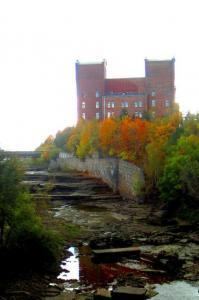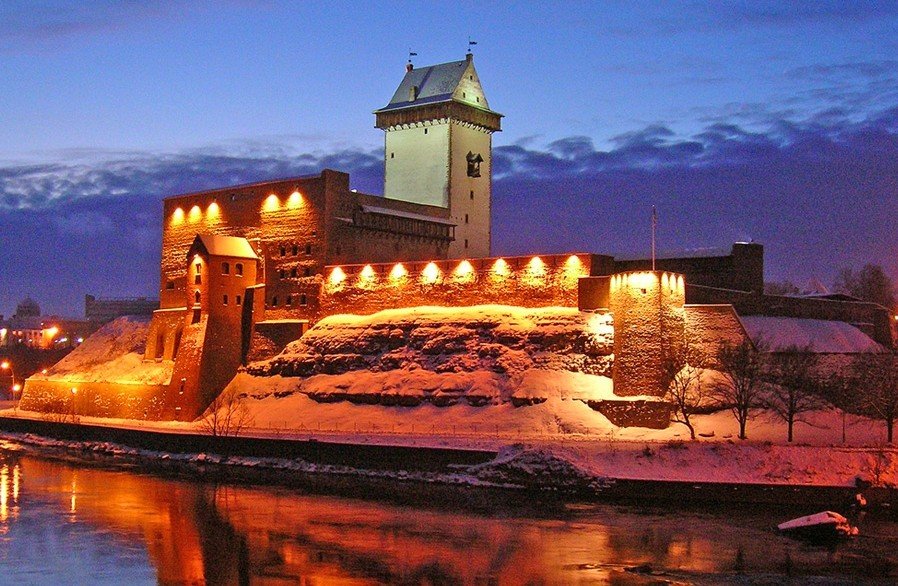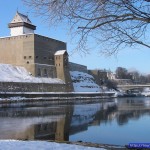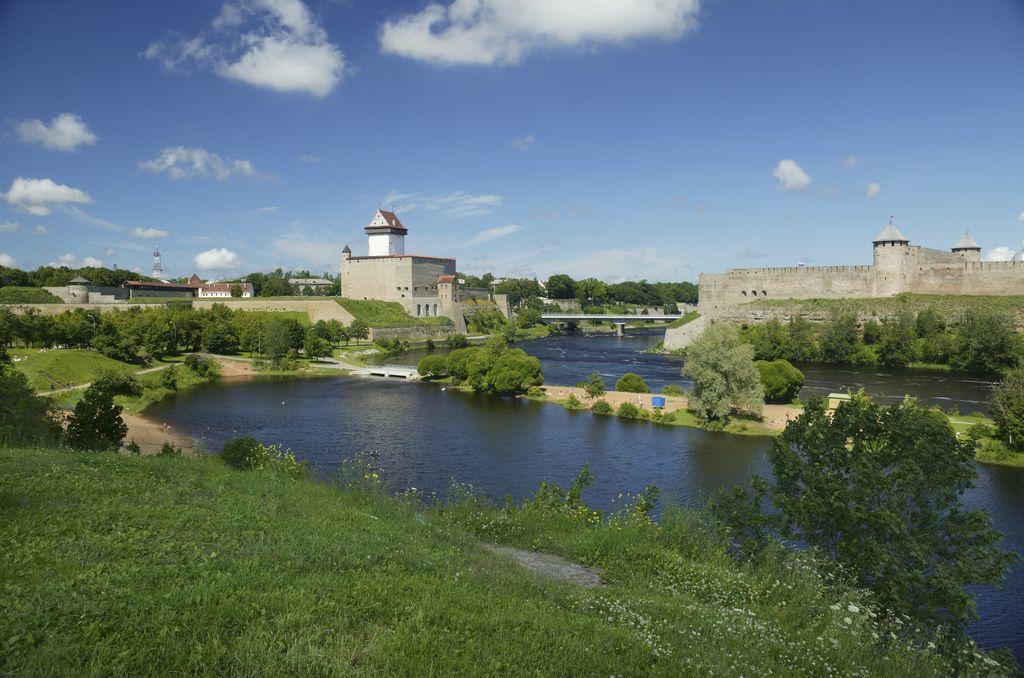Narva is the third largest city in Estonia. It is located at the eastern extreme point of Estonia, by the Russian border, on the Narva River which drains Lake Peipus. The frontier location of Narva is the most characteristic feature of both the past and the present of the town. The historic border has been running there since the Middle Ages, along the banks of rapid river swiftly flowing its waters out the Lake Peipus into the Baltic Sea and dividing the two civilisations – the Catholic European North and Orthodox Slavonic East. However, the border between Estonia and Russia is not a mere line that separates, but also a place where two cultural worlds meet, mutually influence and interpenetrate each other.
It seems as the history had materialised in Narva in its architectural ensemble, uncommon in beauty and dramatic effect, that integrates the opposites and is unique in the whole Europe: two giants of stone towering in close vicinity to each other two opposite banks (at distance of an arrow flight or that of a musket shot) – the castle of Order of Germanic knights and the Russian fortress of Ivangorod. Being the opposites in the architectural style, however, these make up integral ensemble.
Heavy battles occurred in and around Narva in World War II. The city was damaged in the German invasion of 1941 and by smaller air raids throughout the war, but remained relatively intact until February 1944 However, being at the focus of the Battle of Narva (1944), the city was almost completely leveled. The most devastating action was the bombing of 6 March 1944 by the Soviet Air Force, which destroyed the baroque old town, built during the Swedish rule in the late 17th century.
However, Narva is located in a picturesque place. Not far from the town is the Narva Waterfall, whose spillway capacity is one of the largest in northern Europe. Narva-Jõesuu, small cosy spa town, is also within close proximity. From as early as the beginning of the 19. century it grew to become a favorite recreation place for the Saint-Petersburg aristocracy.
Inga Külmoja, Senior Specialist for International Communication at the University of Tartu, is convinced that Narva’s bright days are still ahead:
While you may think of Narva as another boring provincial town, there is actually much more hidden in it. Narva is a different Estonia – and here is why:
1. View, feel and taste Russia
If you haven’t been to Russia, or have only visited Moscow or St. Petersburg and would like to experience more, head to Narva. With 82 percent of its population ethnically Russian and just under four percent Estonian, Narva is pretty much a Russian town.
It might even feel a bit schizophrenic: You will hear Russian spoken ubiquitously, whereas the written language of street names, business signs, and advertising is mostly Estonian.
It’s not just the language, though. It’s also the Russian culture, food, and even the physical presence of Russia across the river. Nice views of the two neighbouring countries can be enjoyed from the balcony of the college’s library in the new building.
Narva on the left and Ivangorod on the right – photo by Jarek Jõepera
2. Time travel in Narva
The frontier location of Narva is the key to the town’s past and its present. The historic border has been located there from the Middle Ages already, along the banks of the rapid river dividing and uniting the two civilisations: the Catholic European north and the Orthodox Slavonic east.
Outside of its military past, Narva has also been a centre of international trade. In Viking times the trade route named in ancient chronicles as ‘The Way from Varangians to Greeks’ started here.
The dramatic history materialised in the architectural ensemble of two fortresses – one in Narva and the other in Ivangorod, Russia – towering at a distance of an arrow’s flight on two opposite river banks. You can still feel the tension reigning between these two.
Narva’s golden age was in the 17th century under Swedish rule, when the downtown area with its Baroque style architecture was built. Unfortunately, only a fraction of its former glory survived World War II.
And, of course, you’ll find many traces of the Soviet period in Narva.
3. Experience the fall of the Industrial Era

The currently abandoned Krenholm Manufacture was established in 1857; its main production fields included spinning of linen, as well as weaving and rendering of textiles. The quality must have been high, as in 1900 Krenholm’s production earned the Grand Prix at the world exhibition in Paris.
Krenholm was a town within a town: In addition to the production buildings, the factory complex included worker’s barracks, shops, a sauna, and even a hospital. The factory ran a two-grade school for the numerous underaged and illiterate employees.
During the Soviet period, Krenholm, with its 40,000 workers, was one of the largest textile factories. It was privatised in 1994 and since then it has reduced its scale of operations by several degrees.
Today the large factory complex stands almost unused, as if embodying the fall of the Industrial Era. However, locals say that the complex recently received new owners whose long-term ambition is to bring the glorious times back to Krenholm, investing into the tourism infrastructure, and erecting magnificent hotels and large-scale conference centres.
4. Visit Narva College in its new building
Narva is also home to University of Tartu’s Narva College. For many of the town’s 64,000 inhabitants, this autumn’s festive opening of the college’s new and long-awaited building on the Town Hall Square was a huge event to celebrate and remember.The University of Tartu’s Narva college is much more than a college in Narva. Standing next to the Town Hall on the grounds of what used to be the Stock Exchange Building, it is also a cultural hub of the town. Locals and visitors alike are welcome to enjoy themselves in the ‘Facebook Hall’, use the wireless Internet, and admire the new building with a strange roof. In fact, the new building is slightly shifted from the old location: Its beak-shaped roof is the would-be roof of the old Stock Exchange Building from the backside.
The cafe – which might well become the best in town soon – will open its doors in the college, too. Exhibitions and film screenings are also on the way. So grab a pillow in the ‘Facebook Hall’, sit down, and experience the flow of time: the past and the present, the old and the modern, the Russian and the Estonian.
The new building of Narva College has an unusual beak-shaped roof and stands next to the Town Hall. Photo by Andres Tennus.
And finally, let me encourage you on your way to Narva with a few practical tips and hints from both locals and guests:
- Narva is safer than you may have heard from the Estonian media. It may feel a bit unsafe at night in some places though.
- Use taxis in Narva – they’re cheap.
- You might need a local guide to explore the most beautiful places.
- Don’t be confused if a shop vendor greets you with such enthusiasm as if you were her old friend. Similarly, it shouldn’t surprise you too much if some shop vendors don’t seem that polite at all.
Cover photo: http://www.narva.ee/ee/





1 thought on “Estonia’s third largest city – four reasons to visit Narva”